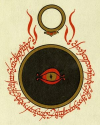In this thread I am going to question whether the One Ring poem was deliberately started at the wrong line?
In episode 151 & 152 of 'Exploring the Lord of the Rings' podcast the One Ring poem is brilliantly workshopped by professor Corey Olsen. The Elvish writing on the Ring says the following Black Speech words:
In episode 151 & 152 of 'Exploring the Lord of the Rings' podcast the One Ring poem is brilliantly workshopped by professor Corey Olsen. The Elvish writing on the Ring says the following Black Speech words:
These words are spoken out loud by Gandalf at the Council of Elrond in Rivendel, which caused a shadow to pass over the high sun and some Elves to stop their ears. Later Gandalf gives the translation as:Ash nazg durbatulûk,
ash nazg gimbatul,
Ash nazg thrakatulûk
agh burzum-ishi krimpatul.
When professor Corey Olsen looked at just the verbs:One ring to rule them all,
one ring to find them,
One ring to bring them all
and in the darkness bind them.
- Rule
- Find
- Bring
- Bind
- Find
- Bring
- Bind
- Rule
And this would translate into something like:Ash nazg gimbatul,
ash nazg thrakatulûk,
Agh burzum-ishi krimpatul
ash nazg durbatulûk.
As you can see I had to add the word 'into' at the start of the last line for the poem to make sense in English (I don't know if this breaks the meter of the English poem, I'm not a poet, sorry if it did...), however, this may not be needed at all in Black Speech and the 'into' part could already be incorporated into the Black Speech 'krimpatul' verb. If this is the case, could Gandalf have started the poem with the conclusion deliberately, so he wouldn't activate some spell or something else alike? A shadow was starting to creep over the sun after all...One ring to find them,
one ring to bring them all,
and in darkness bind them
into one ring to rule them all.




